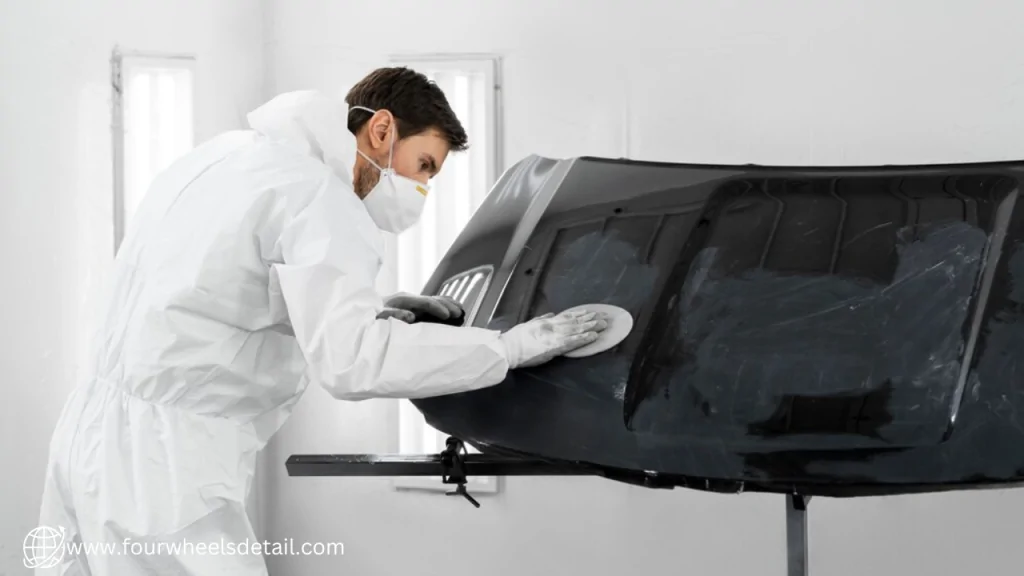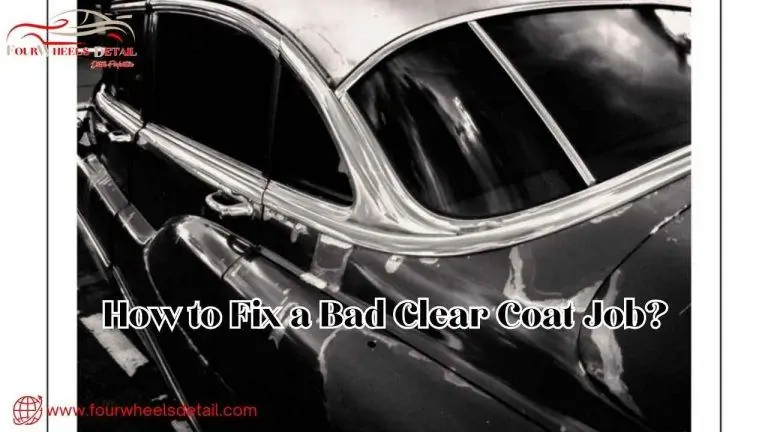How to fix a bad clear coat job, Fixing a bad clear coat job can cost from $150 to $2,500+, depending on damage severity and repair method. DIY solutions may be cheaper, but professional services often yield longer-lasting results and smoother finishes. Protect your car’s paintwork with these expert tips and find out how to choose the right option for your budget and needs!
Table of Contents
ToggleUnderstanding the Problem: What is a Clear Coat?
The clear coat is a transparent layer applied on top of your car’s paint. It provides a glossy finish and acts as a protective shield against UV rays, dirt, and minor scratches. Unfortunately, clear coats can sometimes be applied incorrectly, leading to various issues such as a rough texture, fading, or even peeling.
Common Issues with Bad Clear Coat Jobs:
- Orange Peel Effect: A bumpy, uneven finish that resembles an orange’s skin.
- Swirl Marks and Scratches: Light scratches or marks often visible in direct sunlight.
- Hazing and Fogging: A cloudy appearance that dulls the finish.
- Fish Eyes: Tiny circular craters often caused by contamination or improper application.
- Runs and Sags: Streaks or drips in the clear coat from applying too much in one area.
Assessing the Damage
Before starting, it’s essential to understand the severity of the problem.
- Visual Inspection: Look for irregularities like streaks, haze, or peeling.
- Touch Test: Feel for rough patches or spots where the clear coat is lifting.
- Thickness Measurement: Use a paint thickness gauge if you have one, as it can help identify areas where the clear coat may be too thin.
DIY Repair Options for Fixing Clear Coat Issues
Fixing a bad clear coat job can often be done at home, especially if the damage is minor. Here’s a step-by-step guide to help you tackle this yourself.
Preparation and Materials Needed:
- Sandpaper (1000 to 3000 grit)
- Polishing compound
- Microfiber cloths
- New clear coat spray or paint correction kit
- Safety gear (mask, gloves, and goggles)
Step-by-Step Process: How To Fix A Bad Clear Coat Job

1. Clean the Affected Area
- Wash the area thoroughly to remove any dirt or grease. A clean surface is critical to avoid further contamination during the repair process.
2. Sand the Damaged Clear Coat
- Use 1000 to 3000-grit sandpaper to gently sand the damaged areas. This step smooths out imperfections and removes the old, faulty clear coat layer. Be cautious not to sand through to the paint below.
3. Polish the Surface
- Apply a polishing compound with a microfiber cloth to bring back the shine and smoothness. Polishing will help blend any slight imperfections left after sanding.
4. Reapply a New Clear Coat
- Follow the instructions on your clear coat spray can to apply a thin, even layer. Hold the can 6-8 inches from the surface, and spray in light, even strokes. Allow each coat to dry fully before adding another layer to build up durability.
5. Buff and Finish
- Once the clear coat is completely dry, use a buffing pad to add a final shine to the surface. This step will help the repaired area blend seamlessly with the rest of the car.
Missed Detail: Drying times between coats are crucial to prevent future problems. Each layer should dry completely to create a solid, lasting finish.
Pro Tips for Avoiding Future Clear Coat Issues
- Application Conditions: Apply the clear coat in a dust-free environment with controlled temperature and humidity.
- Technique: Always maintain a consistent distance when spraying, and apply multiple thin coats rather than one thick layer.
- Maintenance: Use wax and sealants to protect the clear coat regularly.
When to Seek Professional Help
If the damage is extensive, or if DIY repairs don’t yield satisfactory results, it might be time to consider professional assistance.
- Signs You Need Professional Help:
- Deep cracks or peeling that expose the paint layer.
- Persistent rough patches or difficulty achieving a smooth finish.
- Cost Considerations: Professional clear coat repair typically costs between $300 and $500, depending on the extent of the damage and the expertise of the detailer.
- Choosing a Reputable Detailer: Look for certified detailers with positive reviews and check their work portfolio.
FAQs
Here are some frequently asked questions about fixing bad clear coat jobs:
Can I reapply a clear coat without removing the old one?
Not recommended. Reapplying over an old, damaged layer often leads to poor adhesion and more issues down the road. It’s best to sand the area before applying a new clear coat.
How long does a clear coat last?
A quality clear coat can last 5-10 years with proper care, but environmental factors and maintenance habits can affect longevity.
What causes clear coat to peel prematurely?
Peeling usually happens due to poor application, exposure to harsh sunlight, or failure to maintain the clear coat. Using a quality product and applying it correctly can reduce this risk.
Is fixing a bad clear coat job DIY-friendly for beginners?
For minor issues, yes, a DIY approach is doable with patience and the right tools. However, severe peeling or cracking may require professional help for the best results.
Do car washes remove clear coat?
Car washes, particularly automatic ones with abrasive brushes, can cause minor scratches and wear down the clear coat over time. However, a single wash generally won’t remove the clear coat entirely.
Does Meguiar’s Ultimate Polish remove clear coat?
No, Meguiar’s Ultimate Polish is a fine polish designed to enhance gloss and prepare the surface for waxing. It does not remove the clear coat, though excessive polishing can thin it slightly.
Does acetone remove automotive clear coat?
Yes, acetone is a strong solvent and can damage or strip the clear coat if left on too long or used in large quantities. It should be avoided on car paint.
Does wax remove clear coat?
No, wax is meant to protect the clear coat, not remove it. Waxing adds a protective layer over the clear coat, helping prevent minor scratches and UV damage.
Does alcohol remove clear coat?
Isopropyl alcohol can strip wax but typically does not damage the clear coat. However, prolonged or excessive use could potentially dull or weaken it.
How to remove clear coat without sanding?
Clear coat can be removed with a chemical stripper or polish designed to cut through paint layers, but these must be used carefully. Sanding is more controlled, so alternative methods carry a risk of damaging the paint layer.
Can clear coat be removed and reapplied?
Yes, a damaged clear coat can be removed and reapplied. However, this often requires professional-grade polishing or sanding to remove the old layer completely before reapplying a new one.
If you want to learn more about car cleaning and detailing, you can look more on our website fourwheelsdetail.com

Hi! I’m Harry, With over a decade of experience in car detailing and cleaning, I specialize in restoring vehicles to their pristine best. Passionate about sharing expert tips on fourwheelsdetail.com, I’m here to help readers maintain their cars’ beauty, from paint protection to tackling tough stains.

